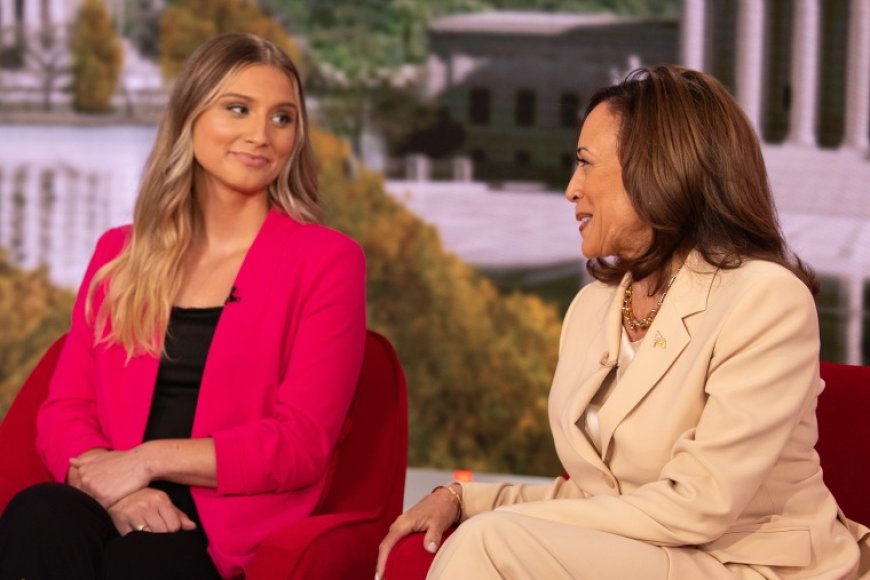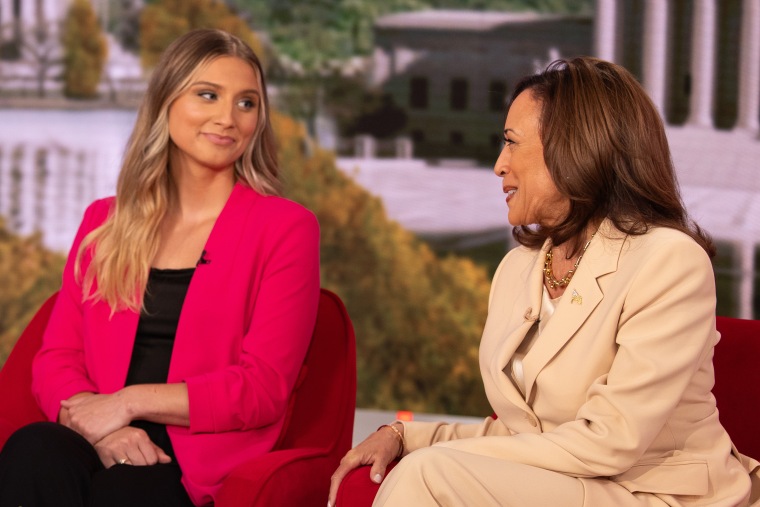Exclusive: Kamala Harris teams with childhood sexual abuse survivor to warn America away from Trump

Vice President Kamala Harris and Hadley Duvall Advocate for Women’s Rights in the Face of a Second Trump Presidency
Vice President Kamala Harris is teaming up with Hadley Duvall, a survivor of sexual abuse, to raise awareness about the potential consequences for women in America if Donald Trump were to be reelected.
During an exclusive interview on “Morning Joe” with co-host Mika Brzezinski, Duvall emphasized the importance of the upcoming election for women’s lives. She stated, “If you have a woman in your life that means something to you, her life is at stake.” Duvall, who survived her stepfather’s abuse as a child, highlighted that women of reproductive age are particularly vulnerable.
The Impact of Trump’s Supreme Court Appointments
Vice President Harris commended Duvall for her bravery in sharing her traumatic experience to advocate for reproductive healthcare. Harris also pointed out the role played by former President Donald Trump in shaping the Supreme Court. She stated, “Let’s be perfectly clear about how we got here. Because the former president hand selected three members of the United States Supreme Court with the intention that they would undo the protections of Roe v. Wade, and they did exactly as he intended.”

Trump’s Abortion Bans and the Fight for Reproductive Freedom
Harris criticized what she referred to as “Trump abortion bans,” including those without exceptions for rape and incest. She highlighted President Biden and her own commitment to making reproductive freedom a central issue in their campaign, aiming to mobilize voters across party lines.
Hadley Duvall’s Story and Advocacy
Duvall, who grew up in Owensboro, Kentucky, first experienced sexual abuse at the age of 5 by her stepfather. At 12 years old, she discovered she was pregnant and later miscarried. The overturning of Roe v. Wade in Kentucky prompted Duvall to share her story on social media.
Duvall also appeared in an advertisement for Kentucky Governor Andy Beshear’s re-election campaign, criticizing his opponent’s stance on abortion. She highlighted the lack of exceptions for rape and incest in Republican Daniel Cameron’s position.
The Importance of Speaking Out
During the interview, Brzezinski asked Duvall how she found the courage to disclose the abuse to her mother. Duvall explained that she was concerned about jeopardizing her mother’s sobriety, as she was a recovering drug addict. Eventually, she mustered the strength to reveal the truth via text message.
As a prosecutor specializing in child sexual assault, Vice President Harris shared her own experience of supporting a friend who was being molested by her stepfather. She expressed her commitment to protecting women and children and condemned the lack of exceptions for rape and incest in recent abortion laws.
The 2024 Election and Key Issues
Trump’s Potential Running Mate: Harris stated that Trump would choose a running mate who prioritizes loyalty to him over loyalty to the country.
The Close Presidential Race: Harris acknowledged that presidential races are often close but expressed confidence in their eventual victory. She cited the American people’s support for individual freedoms, including the right to choose, as demonstrated in previous elections.
Trump’s Claims of Connecting with Black Voters: Harris dismissed Trump’s claims, stating that reducing an entire population to stereotypes is insulting and incorrect.
The Stakes of the Election: Harris emphasized that the election is about preserving freedom and urged individuals to consider the potential consequences beyond reproductive rights.
Protecting Contraception and IVF: Harris urged voters to participate in the November election to prevent conservative efforts to restrict access to contraception and other reproductive healthcare options.
SDGs, Targets, and Indicators Analysis:
1. Which SDGs are addressed or connected to the issues highlighted in the article?
- SDG 3: Good Health and Well-being
- SDG 5: Gender Equality
- SDG 10: Reduced Inequalities
- SDG 16: Peace, Justice, and Strong Institutions
The article discusses the issue of reproductive healthcare and women’s rights, which are connected to SDG 3 (ensuring good health and well-being) and SDG 5 (promoting gender equality). It also highlights the importance of addressing sexual abuse and violence against women, which relates to SDG 10 (reducing inequalities) and SDG 16 (promoting peace, justice, and strong institutions).
2. What specific targets under those SDGs can be identified based on the article’s content?
- SDG 3.7: By 2030, ensure universal access to sexual and reproductive healthcare services, including for family planning, information, and education.
- SDG 5.2: Eliminate all forms of violence against all women and girls in public and private spheres, including trafficking and sexual exploitation.
- SDG 10.2: By 2030, empower and promote the social, economic, and political inclusion of all, irrespective of age, sex, disability, race, ethnicity, origin, religion, or economic or other status.
- SDG 16.2: End abuse, exploitation, trafficking, and all forms of violence against and torture of children.
Based on the article’s content, the targets mentioned above are relevant to the issues discussed. These targets aim to ensure universal access to sexual and reproductive healthcare services, eliminate violence against women and girls, promote inclusion and equality, and end abuse and violence against children.
3. Are there any indicators mentioned or implied in the article that can be used to measure progress towards the identified targets?
- Indicator 3.7.1: Proportion of women of reproductive age (aged 15-49 years) who have their need for family planning satisfied with modern methods.
- Indicator 5.2.1: Proportion of ever-partnered women and girls aged 15 years and older subjected to physical, sexual, or psychological violence by a current or former intimate partner in the previous 12 months.
- Indicator 10.2.1: Proportion of people living below 50 percent of median income, disaggregated by sex, age, employment status, and geographical location.
- Indicator 16.2.2: Number of victims of human trafficking per 100,000 population, by sex, age group, and form of exploitation.
The article does not explicitly mention these indicators, but they can be used to measure progress towards the identified targets. These indicators provide specific measurements related to access to family planning, prevalence of violence against women, income inequality, and human trafficking.
Table: SDGs, Targets, and Indicators
| SDGs | Targets | Indicators |
|---|---|---|
| SDG 3: Good Health and Well-being | Target 3.7: By 2030, ensure universal access to sexual and reproductive healthcare services, including for family planning, information, and education. | Indicator 3.7.1: Proportion of women of reproductive age (aged 15-49 years) who have their need for family planning satisfied with modern methods. |
| SDG 5: Gender Equality | Target 5.2: Eliminate all forms of violence against all women and girls in public and private spheres, including trafficking and sexual exploitation. | Indicator 5.2.1: Proportion of ever-partnered women and girls aged 15 years and older subjected to physical, sexual, or psychological violence by a current or former intimate partner in the previous 12 months. |
| SDG 10: Reduced Inequalities | Target 10.2: By 2030, empower and promote the social, economic, and political inclusion of all, irrespective of age, sex, disability, race, ethnicity, origin, religion, or economic or other status. | Indicator 10.2.1: Proportion of people living below 50 percent of median income, disaggregated by sex, age, employment status, and geographical location. |
| SDG 16: Peace, Justice, and Strong Institutions | Target 16.2: End abuse, exploitation, trafficking, and all forms of violence against and torture of children. | Indicator 16.2.2: Number of victims of human trafficking per 100,000 population, by sex, age group, and form of exploitation. |
Source: msnbc.com








